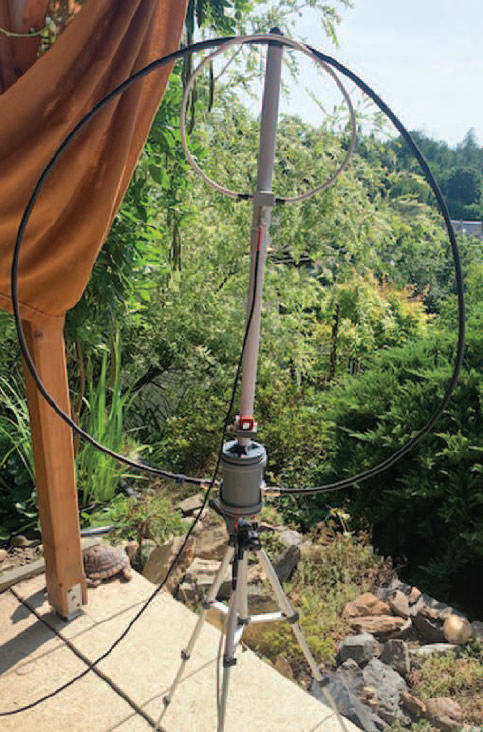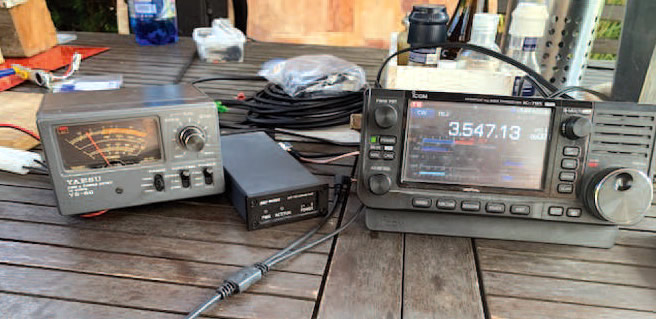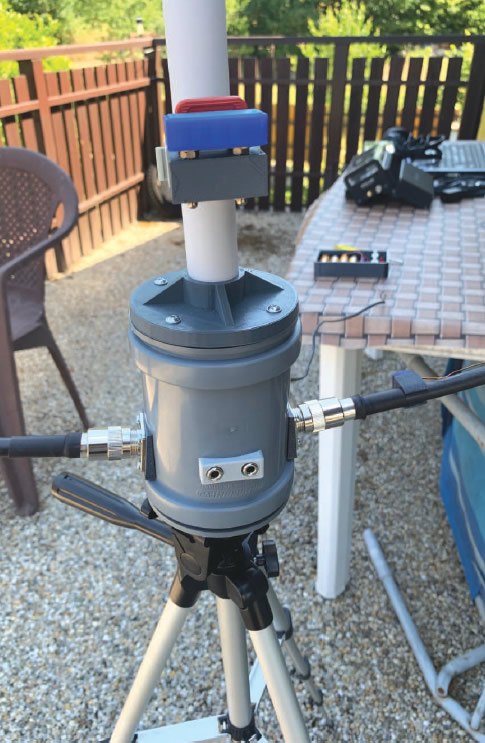Magnetic loop antenna MLA-S (portable RT)
- Home
- Magnetic loop antenna MLA-S (portable RT)
Ing. Ladislav Müller, OK1LO; ok1lo@seznam.cz
 A large number of magnetic loop antennas have been described in PE-AR over the past decade. Most of the articles were written by a few authors; the most active ones were definitely OK2ER and OK1VR. Basically, the MLA theory has been described in detail in our magazine both on the theoretical level, which includes especially the follow-up articles by OK1VR, but also as information about existing products from the development workshop of OK2ER, who enjoys the development and production of MLAs in his post-active retirement.
A large number of magnetic loop antennas have been described in PE-AR over the past decade. Most of the articles were written by a few authors; the most active ones were definitely OK2ER and OK1VR. Basically, the MLA theory has been described in detail in our magazine both on the theoretical level, which includes especially the follow-up articles by OK1VR, but also as information about existing products from the development workshop of OK2ER, who enjoys the development and production of MLAs in his post-active retirement.
It could be said that there is probably not much that can be meaningfully blinked anymore. However, OK2ER has come up w i t h another model that again stands out a bit from the many small commercial types of these loop antennas that can be purchased in the Czech Republic and Slovakia without any creative input - by purchase.
A larger number of types of magnetic loop antennas of lower class, meaning cheap, hand-tuned and up to a usable power of about 20 W, can be found even in the small OK/OM shop. Most of them are limited to the lowest usable frequency (7 MHz band). The MLA-M type OK2ER antennas (described in PE-AR 12/2014, p. 43) and MLA-SMART (PE-AR 05/2020, p. 34), which are applicable from 3.5 MHz onwards. However, the low-power MLA group lacks antennas that are remotely tunable, which is very useful, for example, for placement on the loggia of apartment buildings. These situations are quite complicated for the user in the case of manually tuned MLAs, precisely because of the typical narrowband nature of magnetic loops, except perhaps when operating digital modes, which takes place in the range of a few kHz. The described MLA-S (light QRP) antenna in the RT (remote tuning) version (Figs. 1, 2) follows t h e successful model of the MLA-S (light QRP) antenna tuned manually (see PE-AR 04/2022, p. 34), which, due to its easy disassembly, is ideal for operation in SOTA, WFF and similar activities.
The MLA-S (light QRP) in RT version is visually almost exactly the same as the MLA-S (light QRP) model described in PE-AR in April. The difference is that the knob used for tuning the RX air capacitor is missing - the UNITRA type dual (320/360 pF). For MLA-S (light QRP) in the RT version, a high quality silver-plated military inkurant is pragmatically used - a dual (2x 200 pF), which rotates in a circle and does not need a limit switch. The MLA-S (light QRP) antenna in the RT version has two subtypes: the MLA-S (light QRP RT) v. 1 operates in the bands from 3.5 to 28 MHz, but is limited to 10 W. The MLA-S (light QRP RT) v. 2 can handle 30 W, but is frequency limited to the bands from 7 MHz to 28 MHz. Achieving overlap of all KV bands is made a little more difficult by adding an additional jumper.
 Remote tuning is done by a control box with two buttons controlling the direction of rotation of the motor, an indicator LED, where a bright light indicates fast tuning and a smaller light slow tuning, and a switch for selecting the type of tuning. The control box (Fig. 1) is connected to the antenna by a separate cable, which connects via a 3.5mm connector to the bottom of the MLA cylinder box. It is tuned in two phases: in the first phase - fast tuning - the antenna is coarsely tuned to the desired frequency, in the second phase, using slow tuning, the PSF is finely tuned as low as possible (Fig. 3).
Remote tuning is done by a control box with two buttons controlling the direction of rotation of the motor, an indicator LED, where a bright light indicates fast tuning and a smaller light slow tuning, and a switch for selecting the type of tuning. The control box (Fig. 1) is connected to the antenna by a separate cable, which connects via a 3.5mm connector to the bottom of the MLA cylinder box. It is tuned in two phases: in the first phase - fast tuning - the antenna is coarsely tuned to the desired frequency, in the second phase, using slow tuning, the PSF is finely tuned as low as possible (Fig. 3).
The transceiver or receiver is connected to the antenna via a coaxial cable, which is equipped with a BNC connector on the antenna side.
The antenna is attached to any tripod with a thread (compatible with the standard) at the bottom of the back of the antenna (Fig. 4). For outdoor use, it is recommended to use a more stable tripod for better stability of the assembly in the wind.
No tools are needed to assemble the antenna into working position and the assembly itself takes only a few minutes. It is important to tighten the PL connectors properly.
In the test operation, the antenna was operated with a power of 10 W. When using higher power (up to 30 W), it is necessary to keep a safe distance from the antenna (min. 5 m). Currently, an improved version of the MLA-S (light QRP RT) v. 3 is being developed, which is equipped with a simple rotator (no indication of the position), built directly into the basic, lower part of the antenna.
Parameters MLA-S (light QRP RT) v.1
Bands: 3,5-5,3-7-10-14-18-21-24-28 MHz.
PWR: 10 W.
Parameters MLA-S (light QRP RT) v.2
Bands: 5.3-7-10-14-18-21-24-28 MHz.
PWR: 30 W.
Dimension: diameter 80 cm.
Weight: 1.2 kg.
The MLA-S (light QRP) antenna was described by OK1CJN and OK3TV in [1] and [2]. With the consent of both authors, we choose to use parts of their texts in this article:
Overall rating of MLA-S by OK1CJN
 The MLA-S antenna is foldable, extremely lightweight and easy to transport. The price for the small size and for the increased resistance in the main loop (walking resistors on the PL coefficients required for disassembly) is a slightly lower performance than the larger MLA. On the other hand, when tuning the MLA.
The MLA-S antenna is foldable, extremely lightweight and easy to transport. The price for the small size and for the increased resistance in the main loop (walking resistors on the PL coefficients required for disassembly) is a slightly lower performance than the larger MLA. On the other hand, when tuning the MLA.
With a certain frequency it is possible to move further away from it without rapidly deteriorating the PSF. This is useful for portable operation with manual tuning. The reproducibility of the tuning is so good that once the optimum setting for the intended operating frequency has been found in the comfort of home (condenser and FCL position), it is possible to go into the field without a larger PSF meter. A PSV indicator (such as the one in the FT-817) is sufficient for fine-tuning (tenths of a scale). The MLA-S can also be used as a branch suspension.
Although the MLA-S is designed with the aim of primarily portable QRP use, it is also suitable for balcony use. Thanks to its small size, it is unobtrusive and does not attract unwanted attention. The maximum permissible power of 30 W is too high for such a location.
Together with the authors of the antenna, I want to emphasize at this point that the antenna should be tuned with low power and do not stick your head into the loop even at 5 W.
In terms of performance, the MLA-S performed in an open direction with appropriate placement on the porch of the house even almost the same power at 14 MHz as when placed on a flat roof.
Naturally, its performance cannot be compared to full-sized dipoles or even directionals, but that is not the point. The shortwave "all-bandwidth" of the MLA-S is unique and fascinating for such a small size, and is enhanced by the ease of switching to a different frequency range.
Operational testing was carried out by telegraph operation on 7 MHz and 14 MHz and the practical results were not bad at all (DX 6400 km). Even with low power, the digital link (FT8) fans can reach even greater distances than it seemed to me with the telegraph.
Jirka, OK1CJN, ok1cjn@qsl.net
MLA-S rating by OK3TV:
 I am currently mostly experimenting with the MLA-S antenna. The tuning capacitor is made (as far as I know) by Slavek, OK1TN, and is built for the voltage of several kilovolts that appears on the main loop. My version can handle 10 watts of power from the transceiver, but I've heard that Slavek has developed a better model for significantly higher power. I made the main loop and the tie loop from RG-213, which is sufficiently rigid and does not require further fixation when the loop is fixed on top. The main loop is connected to the capacitor by standard PL connectors. With the correct loop sizes, the antenna is capable of tuning in bands from 80 m to 10 m. A jumper can be inserted into the capacitor to activate another circuit: with the jumper open, the antenna tunes from 40 m upwards, with the jumper short-circuited to 80 m, and with a small capacitor of a certain capacitance connected, it tunes to 40 m.
I am currently mostly experimenting with the MLA-S antenna. The tuning capacitor is made (as far as I know) by Slavek, OK1TN, and is built for the voltage of several kilovolts that appears on the main loop. My version can handle 10 watts of power from the transceiver, but I've heard that Slavek has developed a better model for significantly higher power. I made the main loop and the tie loop from RG-213, which is sufficiently rigid and does not require further fixation when the loop is fixed on top. The main loop is connected to the capacitor by standard PL connectors. With the correct loop sizes, the antenna is capable of tuning in bands from 80 m to 10 m. A jumper can be inserted into the capacitor to activate another circuit: with the jumper open, the antenna tunes from 40 m upwards, with the jumper short-circuited to 80 m, and with a small capacitor of a certain capacitance connected, it tunes to 40 m.
I have found that it depends on the angle of the main and coupling loop: on some bands the best tuning is achieved at 0°, on some at up to 45°.
I use MLA-S antenna together with FT- 818 and an output of 5 - 6 W. However, I must say that the efficiency of the MLA- S is not very good on the lower bands. The antenna works best on 20 m and of course 10 m, although I have the impression that the MLA-ER works a little better on 10 m.
Of course, I compared the results of the MLA-S with large wire antennas such as the end-fed half-wave dipole (EFHW) or OCF dipole, and of course these antennas work better. The exception is perhaps 10 m, where one can benefit from the directivity of the MLA-S. However - let's compare the space and mounting requirements of these long wire antennas with the small MLA! Either way, hunting for QRP contacts with the MLA-S is an interesting sport.
Tomas, OK3TV
Sources
[1] Nemejc, J, OK1CJN: MLA-S antenna. Hamik's Corner www,hamik,cz
[2] Valla, T, OK3TV: MLA antenna OK2ER. OK QRP Info No. 120. April 2022.